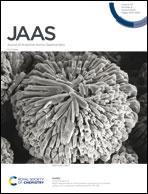3D-printed total consumption microflow nebuliser development for trace element analysis in organic matrices via inductively coupled plasma mass spectrometry
Abstract
A new total consumption micronebuliser for ICP-MS was developed and optimised in this work. This nebuliser, V64-01, which was built through 3D printing, contains a larger internal diameter than other total consumption micronebulisers, a silicon-free capillary that perfectly tolerates a flow up to 65 μL min−1 THF, and the chances of incurring obstructions or clogging during a prolonged period of analysis are reduced. In addition, its production costs are minimal. To validate this nebuliser, its most important parameters were optimised (carrier gas and liquid flow rates), and the quantitative analysis of an SRM sample was carried out successfully. Calibration curves with great linearities (r2 > 0.999) and detection limits between 0.84 and 2.85 ng g−1 were obtained for the analysis of 10 elements. In addition, GPC-ICP-MS chromatograms of the size distribution of V and Ni species in a reference crude oil sample were obtained, showing the same profile as with the previous nebulisers but also suggesting that, for some species of V and Ni in crude oil, permanent retention might have occurred within the fused silica capillary that connects the DS-5 total consumption micronebuliser with the HPLC system. This new 3D-printed total consumption nebuliser possesses the potential to become a good consumable that will allow for total and speciation analysis of numerous trace elements, such as Si, that, until now, due to either interactions with silica or interferences, were not possible to analyse.



 Please wait while we load your content...
Please wait while we load your content...